by Don MacGregor
At ImagingUSA 2016, the late Ken Whitmire received the Lifetime Achievement award. His acceptance speech was a powerful message to all photographers who put the word “professional” in a new perspective. What does “professional” mean? Does it mean getting paid for a job? Technically, yes.
However, Ken defined it as meaning far more than dollars and also said that we should be PROUD to be a professional and that’s where Texas School steps forward. A real professional needs to have a depth of knowledge and skills to enable results that visually stand head and shoulders above those who focus on gear or “sexy” images or keep their cameras on motor drive hoping for something good.
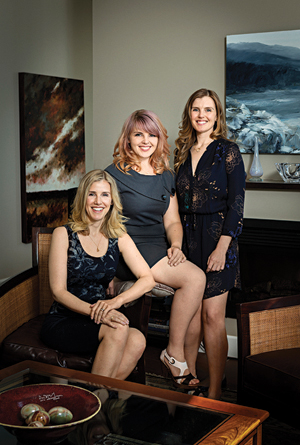
The key components to professional images are Posing, Lighting and Composition. Family groups are often considered the most difficult and, without doubt, the most profitable. Good posing should reflect a relaxed contemporary approach, yet should still be flattering (to all sizes and shapes). In groups, each person should be showcased to belong to the family and have equal representation (unless hiding weight). Little details MUST be a part of the photographers final efforts. Often, simplicity is the very best approach.
Lighting should showcase the subjects, have a three dimensional feeling, and insure the expressions are alive and vibrant. Using pure, natural light can be amazing although we often need to add flash or reflectors. When doing so, the quality and quantity of the light should be consistent with the overall mood and concept.
Composition is a very important part of the process. Choosing environments that have natural beauty is easy. The challenge is to create the relationship between the subjects and background such that there is a repetition of design and color, yet showcase the family. Also, the position of the subjects in the overall frame can emphasize the family while letting your eye move through the image and embrace the natural beauty.
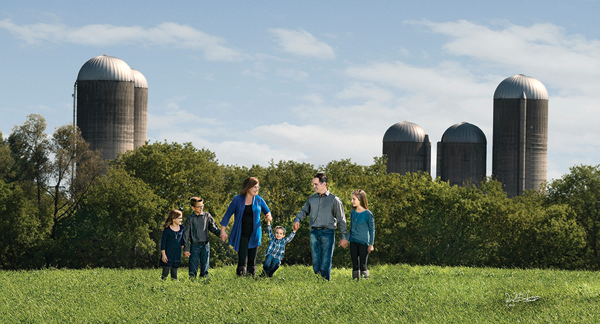 The image of the family on the farm above is a good example of a relationship style of image which is very powerful and emotionally rewarding. The family is walking (in a straight row horizontally) and it was coached and practiced as everyone MUST be equidistant from the camera. The lighting was challenging because it was mid day and total sunshine with clouds dropped in later during enhancement. The family was essentially back lit (and a little side lit), so the exposure on the shadow side of the faces was approximately 3 stops less than the scene. Flash was used to fill the exposure difference, being careful to keep the flash as close to the axis of the lens as possible and slightly from camera right, which is the direction of the sun. In the composition, note how the silos are all tall and vertical. We had to make the family repeat that design and then “frame” them with the silos. The design screamed to be a long skinny horizontal. Don’t be afraid of selling images based on composition (not standard sizes).
The image of the family on the farm above is a good example of a relationship style of image which is very powerful and emotionally rewarding. The family is walking (in a straight row horizontally) and it was coached and practiced as everyone MUST be equidistant from the camera. The lighting was challenging because it was mid day and total sunshine with clouds dropped in later during enhancement. The family was essentially back lit (and a little side lit), so the exposure on the shadow side of the faces was approximately 3 stops less than the scene. Flash was used to fill the exposure difference, being careful to keep the flash as close to the axis of the lens as possible and slightly from camera right, which is the direction of the sun. In the composition, note how the silos are all tall and vertical. We had to make the family repeat that design and then “frame” them with the silos. The design screamed to be a long skinny horizontal. Don’t be afraid of selling images based on composition (not standard sizes).
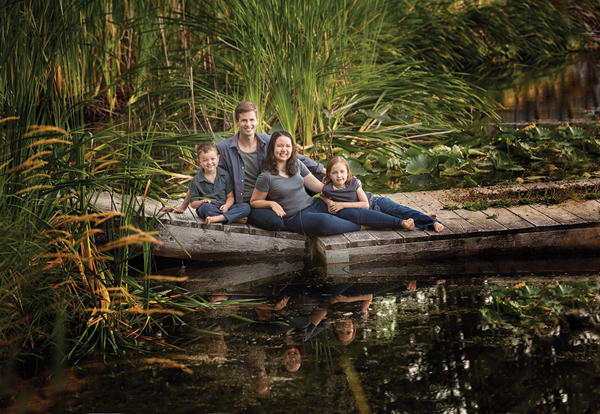 In the example above of the family on the pier, the group is close together, yet each person has space. The body language flows horizontally for the most part. There is a sense of triangles that is powerful. The lighting is totally natural. There is a tall wall of trees to camera left which overhangs the subjects and an open panel of sky to camera right which provides the main light. The value of illumination on the background is the same as the subjects, so everything is in the same key. The composition breaks the rules. It is “bulls eye” composition but it works with the dark foreground and the elements of the grasses that “frame” the family.
In the example above of the family on the pier, the group is close together, yet each person has space. The body language flows horizontally for the most part. There is a sense of triangles that is powerful. The lighting is totally natural. There is a tall wall of trees to camera left which overhangs the subjects and an open panel of sky to camera right which provides the main light. The value of illumination on the background is the same as the subjects, so everything is in the same key. The composition breaks the rules. It is “bulls eye” composition but it works with the dark foreground and the elements of the grasses that “frame” the family.
A slightly different family grouping is shown in the image of the family photographed on the shore of the lake below. The tree stump was a natural to work with and allowed the opportunity of repeating the kids in the design of the stump and also a triangle. With most families, I often make two groupings…
the parents and then the kids. You don’t want to make that separation too much because it can visually separate the family. The heavy umbrella of branches and foliage (not visible in image) subtracted the natural overhead light on this heavy, overcast day.
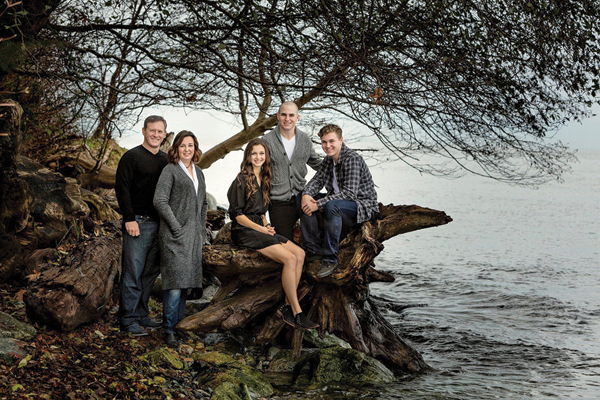 A Canon Speedlight flash on a long pole was used from camera right, set on manual. It added approximately 60% of the final exposure (light is accumulative and the current meters will give you the ambient, the flash, and the combined exposure). 60% is roughly one stop above the ambient reading. That makes a main light, but not aggressive or a head edge, transfer from highlight to shadow and the ratio is believable as it relates to the scene. In the composition, I constantly strive to find locations where there is a sense of natural depth and then figure out how to add people. Note how the diagonal line from the father leads through the mother and then to the daughter and a new triangle comes back up and down. In composition, triangles are awesome.
A Canon Speedlight flash on a long pole was used from camera right, set on manual. It added approximately 60% of the final exposure (light is accumulative and the current meters will give you the ambient, the flash, and the combined exposure). 60% is roughly one stop above the ambient reading. That makes a main light, but not aggressive or a head edge, transfer from highlight to shadow and the ratio is believable as it relates to the scene. In the composition, I constantly strive to find locations where there is a sense of natural depth and then figure out how to add people. Note how the diagonal line from the father leads through the mother and then to the daughter and a new triangle comes back up and down. In composition, triangles are awesome.
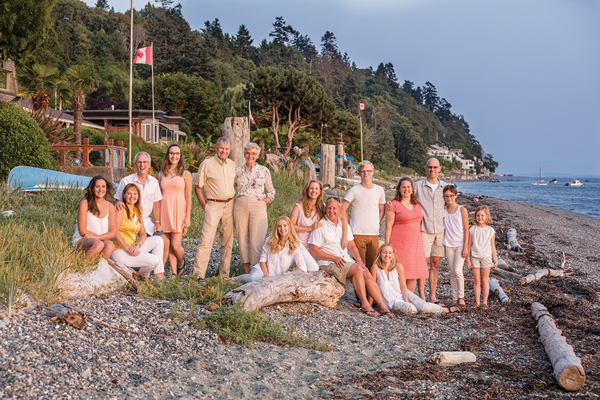 Do you need help with large groups? Consider this image of a large group on the beach. The key to posing large groups like this is to “divide and conquer.” A group of 15 (like this) is simply 15 groups of ONE, linked together using diagonal lines and triangles. Each person has their own space and no one is “hidden” or minimized in the group.
Do you need help with large groups? Consider this image of a large group on the beach. The key to posing large groups like this is to “divide and conquer.” A group of 15 (like this) is simply 15 groups of ONE, linked together using diagonal lines and triangles. Each person has their own space and no one is “hidden” or minimized in the group.
The lighting was totally natural, taken at sunset, with the sun setting to the camera right. It is a sunny day with no clouds. In a situation like this, you have to wait till the sun is setting right on the horizon line so you can use direct sunlight. The beauty is that the light on the subjects is the same as the light on the background, so everything is in key.
A large family like this MUST be a horizontal group composition in order to keep everyone sharp. Note how your eye goes to the family yet drifts through the complete scene from foreground to background. A shallow depth of field (5.6 to 6.3) works if all the people are on the same plane and allows the background to be there but not intrusive.
Finally, consider “relationship images” such as the example below. They bring out a lot of emotion and are great sellers. The key is to insure that everyone is showcased and the image is not simply a “sardine” can of people jumping around on a couch. While candid or animated images are a wonderful contribution to a story or album about a family, they sometimes look too much like images that the clients can do on their own with the camera doing all the work. The young gals body language (arms) is a separate discussion. The parents felt it was “her” because that is what she did. It was natural.
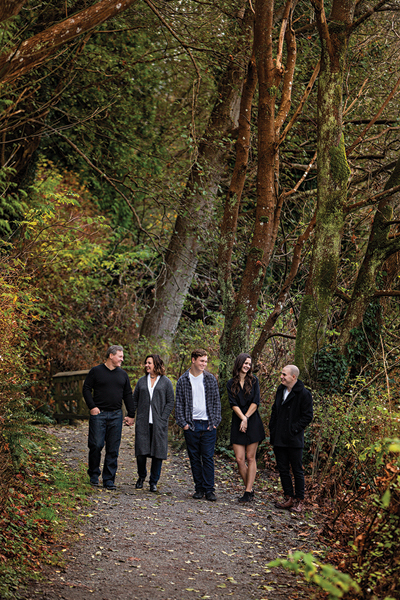 The location for this family image was in a trail with a good sized opening in the trees to camera right. The left side and overhead was totally fall foliage and branches. I used an exposure of ISO 400, 1/60th at 5.6. When I scout locations, I look for the natural elements that might make a good pictorial. Then I work on how I can add the family and repeat the design. A “seated” composition, in this case, simply would not have worked
The location for this family image was in a trail with a good sized opening in the trees to camera right. The left side and overhead was totally fall foliage and branches. I used an exposure of ISO 400, 1/60th at 5.6. When I scout locations, I look for the natural elements that might make a good pictorial. Then I work on how I can add the family and repeat the design. A “seated” composition, in this case, simply would not have worked
Creating professional images that set you apart from other photographers is the underlying theme of the Texas School of Professional Photography. But it is more than just a school. It is a chance to embrace the experience of so many talented people and adding those skills and attitude to your everyday approach. By the end of the week, you will totally understand what it is to be PROUD of being a professional photographer.
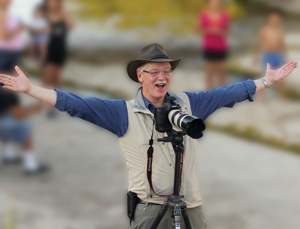 Don MacGregor, M.Photog.Cr.CPP,MPA,F/PPABC/A is from Vancouver, B.C., but is a true Texan at heart. A regular instructor for many years at the Texas School of Professional Photography, Don opened his studio in 1974 and specializes in wall portraits and wedding work. To learn more about Don MacGregor and his class, go to TexasSchool.org and sign up for a week of intensive study under one of the finest portrait photographers of our generation who is committed to the pursuit of excellence.
Don MacGregor, M.Photog.Cr.CPP,MPA,F/PPABC/A is from Vancouver, B.C., but is a true Texan at heart. A regular instructor for many years at the Texas School of Professional Photography, Don opened his studio in 1974 and specializes in wall portraits and wedding work. To learn more about Don MacGregor and his class, go to TexasSchool.org and sign up for a week of intensive study under one of the finest portrait photographers of our generation who is committed to the pursuit of excellence.










